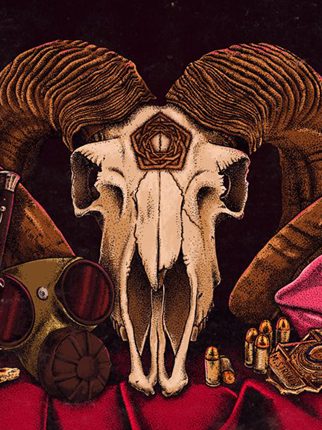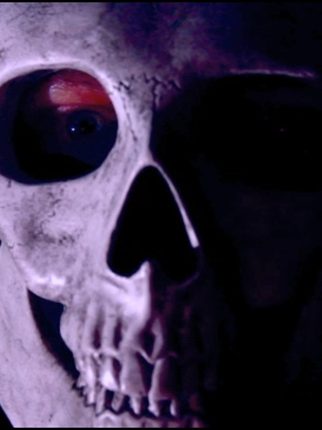Synthwave of Horror Part 1: Disasterpeace

Welcome, Insomniac readers, to part one of a very special Halloween series on electronic horror music. We will be interviewing electronic dark-artists who dabble in the diabolical side of dance music and musicians responsible for some of the most horrific of electronic horror movie scores. We will be capping it off with the sinister synth master himself, John Carpenter, who popularized the use of electro in horror movies and was responsible for directing classics like The Thing, Escape From New York and, appropriately, Halloween.
But first, meet Rich Vreeland (aka Disasterpeace). His retro electronic music can be found in critically acclaimed video games like Fez (which won the Seumas McNally Grand Prize at the Independent Game Festival in 2012) and the terribly difficult Bit.Trip game series, and later this fall, his work will be featured in an episode of Cartoon Network’s Adventure Time.
Last year, his music appeared in arguably one of the best horror movies in ages, David Mitchell’s It Follows. Featuring Vreeland’s haunting electronic and chiptune-themed score, It Follows exemplified the relationship that electronic music and the horror genre has had for years. Not to mention, it scared the shit out of moviegoers with its vicious tracks, raw visuals, and masterful pacing.
Vreeland took time from working on his latest game score for the beautifully designed Hyper Light Drifter to talk to us about the film that he called “dark and psychological, but with a big heart.” And check out his classic horror playlist below.
How did you get involved with It Follows?
Dave Mitchell, the director, played the game Fez in like 2012 and liked the music. So, he sent me an email asking if I’d like to work with him on his next film. At that point I was kind of busy with other projects, and I didn’t think I could find the time, so I actually said no a couple of times to David. But he was really persistent, so I eventually kind of caved in.
“You can do a lot of weird, unsettling things with it, so I think it fits really well with a lot of the emotions that horror film directors try to capture.”
Did you have a lot of experience making music for that genre?
I actually had very, very little experience with horror music. I had done a lot of video game music, and I did some creepy stuff for this game called Puzzle Agent, but that was more of a noir detective-style game. So, this was pretty new territory for me, and that was definitely appealing.
For horror music being something you weren’t used to making, you got a lot of acclaim for the soundtrack. Some critics have even said it is one of the best in years. How did that hit you?
It’s awesome and definitely something I didn’t expect. I think what David brought to the table really helped me a lot. They put together a really good temp score with a lot of good, solid reference points like John Cage, John Carpenter and Johnny Greenwood, so it was a pretty healthy dose of stuff to listen to and inspire my original pieces.
So, you basically got a crash course in electronic horror. Using synth music, especially in the ‘80s, was kind of a common thing. A lot of genres don’t have that kind of marriage to a specific type of music. Why do you think that is?
I think part of it stems from the exploration of the unknown. I think synth music—because it’s not rooted in traditional instruments, and because humans can’t generate these kinds of sounds—it lends itself well. You can do a lot of weird, unsettling things with it, so I think it fits really well with a lot of the emotions that horror film directors try to capture.
It’s kind of unnatural, just like the movies are supernatural. What are some of your favorite horror-type songs that you’ve heard that you thought hit that creepy theme?
I really liked the band Goblin and listened to a lot of that stuff in my most formative years as a musician, like as a late teen, early 20s—and by extension of that, some more contemporary bands that were inspired by Goblin, like Zombi and stuff like that. So, music like this was definitely on my radar, and that was one of the reference points that I brought to the table when I started working on It Follows.
Do you think those types influences bled into the movie for the director, too? For instance, we are finishing this series with director John Carpenter; were his movies an influence?
For sure. I mean, I think you’d have to ask him about the specifics, but my impression is that David has a lot of influences, and he likes to wear them on his sleeve. He’s definitely a student of film, and I think he pulls from a lot of different areas.
Your title track, for instance, really spoke to me. It feels as iconic as Halloween’s or even The Exorcist’s title track. It really captured something for people and created an atmosphere.
The title track was actually inspired by the song “Death” from Fez. David wanted something like that for the title for the film, and I definitely thought it was a good direction to take it… something that is simple and very impactful and has these long, doom-ridden sort of tones to it. I think it’s just the right kind of vibe for the film.
Can you explain more about that simplicity and the use of minimalism? It is a very common theme among horror soundtracks. Why do you think it works so well?
I think the allure of minimalism is that there’s effectiveness to simplicity and repetition. I think John Carpenter’s music did that very effectively, as well. If you can just tap into something that’s essential like that, it can evoke a lot of different feelings and leaves a lot to the imagination, as opposed to a piece that has lots and lots of depth. That can feel a bit more like you’re on a ride, more adventurous, more dictating the terms for you. There’s something about minimalism that creates space for the listener. There’s a personal interactivity to it that I like, and in this film it seemed to scare a lot of people.
Can you tell me more in your own words about your history and some of the games you’ve worked on, just as background?
I discovered independent games and that whole community, and got excited about that. I started finding projects to work on—mostly small, free games that were for competitions, nothing too serious. Eventually I met the developers for Fez, and that was kind of my first big break, because that game ended up doing really well.
It was a fantastic game. In terms of games and other media, do you think there are any others that have sort of tapped into the same type of music you made for It Follows? For instance, when I saw the film, I automatically thought about Drive and Hotline Miami.
That’s cool. I can kind of see those connections—especially in Hotline Miami, which I quite like. The music in that game was very visceral and gritty, very much tied to the action-packed gameplay and breakneck forwardness. I definitely feel like its music was similar to what I did in It Follows, in that it was very intense. I think the music was almost its own character in the film.
In that respect, what sort of role does your music play in a film like this, where the threat is completely silent?
I think because the monster is silent, the music is given a lot of room to fill in the ramifications of what is happening, and to really emphasize the intensity of what the characters are dealing with. It helps to personify the action. I think the opening scene is a great example of this, because you as the viewer don’t actually see anything except the girl trying to get away, but the music escalates in conjunction with her fear.
Where do you think this movie and this score sit next to more contemporary horror movies?
The closest thing I’ve seen to a contemporary horror movie in the last great while is probably Under the Skin, which I really thought was excellent. The score for that, by Mica Levi, is great. The music is extremely textural and rhythmic, which I really like a lot. I thought that was a really unique treatment. I think It Follows is a pretty melodic score, so in that way it has a lot in common with ‘80s scores and old video game soundtracks, to some degree.
Is there anything you’d like to add? Anything you want me to say to John Carpenter?
Tell him that I said thank you for everything he’s done. If it weren’t for him, I’m not sure that this movie would have been made in the same way.
Disasterpeace’s Classic Horror Playlist:
Maurice Ravel “Gaspard de la Nuit. No. 2. The Gibbet (Le Gibet)”
Krzysztof Komeda “Lullaby”
Tom Guycot & Bucky O’Hare “Get to the Roof”
Jonny Greenwood “Open Spaces”
Magyar Posse “Sudden Death”
Erik Satie “Gnossienne No. 1”
Jonny Greenwood “Moon Trills”
Maurice Ravel “Miroirs No. 2”
Cheap Dinosaurs “Dawn of the Dead”
Mica Levi “Death”
For more from Rich Vreeland, check out his music in other games like Hyper Light Drifter, and keep an eye out for his episode of Adventure Time in November!
Follow Disasterpeace on Facebook | Twitter | SoundCloud





